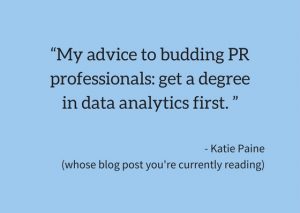The communications measurement world has been talking about the “coming data revolution” for years.
I’ve got news for y’all.
It’s here.
I was at the 2017 PRSA Maryland Annual Conference and noticed a breakout session called “Measuring up: Concrete Ways to Show the Real Value of PR, Social and Marketing”. My first thought was, “Oh great, another talk on ‘real value’ with an ill-defined version of ROI.” But since I had two hours to kill before hosting my own session, I figured I’d sit in.
What came next was the measurement equivalent of a fine wine, a 5-star meal followed by a hot tub under the stars with a full moon. Nary a word about impressions, AVEs, or hits was uttered in the 60 minutes I sat there, enraptured.
Sam Ruchlewicz, director of digital strategy and data analytics at Warshawski, a Baltimore-based integrated communications firm, had me at his introduction.
His background and multiple degrees are in business, analytics, and data. And he is revolutionizing communications measurement with the latter.
He uses an elegant combination of traditional marketing metrics like conversion rates and long-term customer value in conjunction with data like “marginal increase in search”, “brand recall”, and “amplification”.
There’s no magic bullet in his presentation nor any one measurement platform that will provide all the data. He uses survey research, Google Analytics, Hubspot, and CRM systems to get most of his impact data, but also braids in data from key media placements, sentiment, and engagement.
And, while many in the audience were a little glassy-eyed by the end of the hour, the principles were understood. The key was establishing clear definitions of the expected business impact with clients in advance of the beginning of any campaign. That’s right. START WITH THE BUSINESS GOALS.
Though Ruchlewicz is right to preach this, he isn’t alone in the approach.
In the last year I’ve spoken to dozens of organizations that have decided that 2017 will be the year that they move from measuring activities to measuring impact. Problem is, that switch requires a lot of data that most PR people aren’t used to seeing, data from platforms like Adobe Omniture, HubSpot, Google Analytics, and AdWords, just to name a few.

PR has lived in a windowless room for decades. Whether I’m working with an agency or a corporation, I’ve heard the words “We can’t get access to that data” far too often. In a few cases, it may be true, but in most, if you explain that you need that data to improve your efficiency, sooner or later someone further up the chain of command will say “yes”.
PR people just don’t know what to ask for. My advice to budding PR professionals: get a degree in data analytics first.
Data is revolutionizing PR analytics for a simple reason: so much of what we’ve traditionally measured is suspect now. Fake news, bot-generated shares, and exaggerated impressions mean that no one believes the numbers we’ve been using for years.
The Harvard Business Review recently published a study that decimates and discredits social media data. (Is it just me or does it feel like we’ve been slaves to the stuff for what feels like forever now?)
The research proves that likes, shares, and engagement are not a predictor of action or behavior at all. It turns out that people who buy from a brand are simply more likely to engage with that brand after the purchase.
For decades, people have been confusing activity with results, and reporting on a lot of stuff that doesn’t relate to the business. Now, in this era of mass skepticism in boardrooms and among clients, those numbers simply will not fly.
We need to use data that shows our contribution to business goals, and think of PR measurement as an integral part of the marketing and communications function.
The data revolution has arrived.
And not a minute too soon.








